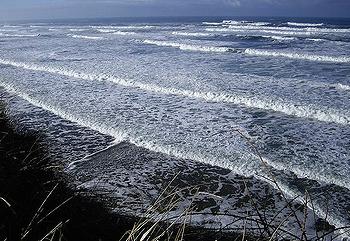
NEWPORT, Oregon, January 15, 2013 (ENS) – The nation’s first utility-scale, grid-connected wave energy test facility will be located at Newport on the Oregon coast, where powerful waves roll in from across the Pacific Ocean.
The new facility, called the Pacific Marine Energy Center, will test energy generation potential and the environmental impacts of wave energy devices, at an ocean site about five miles from shore.
Subsea cables will transmit energy from the wave energy devices to the local power grid, and data to scientists and engineers at on-shore facilities.

The Northwest National Marine Renewable Energy Center, NNMREC, based at Oregon State University, announced the selection of Newport on Monday.
In an extensive site selection process, NNMREC worked with four coastal communities to consider both technical criteria and community resources. The options were narrowed last fall to Reedsport and Newport. Site selection teams from those communities submitted proposals in December.
Belinda Batten, director of NNMREC, said the communities were similar in their capacities and capabilities, and the final choice focused on making PMEC a global competitor among international test facilities.
The selection was based on ocean site characteristics, marine and on-shore cable routes, port and industry capabilities, impacts to existing ocean users, permitting challenges, stakeholder participation in the proposal process, and support of the local fishing communities.
One of the first public wave energy testing systems in the United States has already begun operation near Newport.
The Ocean Sentinel is a $1.5 million device developed by NNMREC. It allows private industry or academic researchers to test new wave energy technology such as a “WetNZ” device developed by private industry and tested last summer.
“The Ocean Sentinel will provide a standardized, accurate system to compare various wave energy technologies, including systems that may be better for one type of wave situation or another,” said Sean Moran, ocean test facilities manager with NNMREC.
“We’re still trying to figure out what will happen when some of these devices have to stand up to 50-foot waves,” Moran said. “The ocean environment is very challenging, especially off Oregon where we have such a powerful wave energy resource.”
“We have to find out more about which technologies work best, in what conditions, and what environmental impacts there may be,” Moran said. “We’re not assuming anything. We’re first trying to answer the question, ‘Is this a good idea or not?’ And if some technology doesn’t work as well, we want to find that out quickly, and cheaply, and the Ocean Sentinel will help us do that.”
The new multi-million dollar grid-connected Pacific Marine Energy Center will be a continuation and expansion of the work of the Ocean Sentinel.
The first installment of funding for PMEC was received in September 2012, consisting of $4 million from the U.S. Department of Energy, along with a non-federal cost match. NNMREC will continue to work with a variety of partners to develop additional funding sources.
“PMEC represents a major step toward the development of energy from Oregon’s ocean waters,” said Jason Busch of the Oregon Wave Energy Trust. “I’m certain that Oregon will reap benefits from PMEC for many years to come, and the research and development performed at PMEC will help usher in this new form of reliable electricity from the sea.”

PMEC design and specific site characterization will begin soon, along with the permitting and regulatory process.
The exact ocean location for the PMEC site will be finalized in the next few months in a zone that has been selected in collaboration with ocean stakeholders – an area that will not impede shipping lanes and takes environmental impacts into consideration.
The Pacific Marine Energy Center will have four “test berths,” open spaces of water dedicated to testing individual devices or small arrays of devices, each of which will be connected to the community’s electrical grid. It will also collect data associated with environmental and human dimension impacts.
Completion will take several years.
“This site selection builds on the global reputation of Oregon State University in both renewable energy research and marine science,” said Rick Spinrad, Oregon State University vice president for research. “Future research results from this site will help ensure our state’s leadership in these critical areas.”
Newport is already a center for marine science and operations of the National Oceanic and Atmospheric Administration, NOAA, and many other agencies.
The NOAA Marine Operations Center-Pacific, opened in Newport in 2011, is the homeport for four NOAA research and survey ships and provides administrative, engineering, maintenance and logistical support for NOAA’s Pacific fleet.
The ships in NOAA’s Pacific fleet collect data essential to protecting marine mammals and coral reefs, managing commercial fish stocks, understanding climate processes, and producing nautical charts. NOAA ships also deploy and help maintain buoys that gather oceanographic and weather information and warn of tsunamis.
The Hatfield Marine Science Center at Newport is Oregon State University’s campus for research, education, and outreach in marine and coastal sciences. It hosts Coastal Oregon Marine Experiment Station, the Cooperative Institute for Marine Resources Studies, and the Marine Mammal Institute. Onsite partners include eight state and federal agency activities involved in research and management of the marine environment.
Copyright Environment News Service (ENS) 2013. All rights reserved.
© 2013, Environment News Service. All rights reserved. Content may be quoted only with proper attribution and a direct link to the original article. Full reproduction is prohibited.
